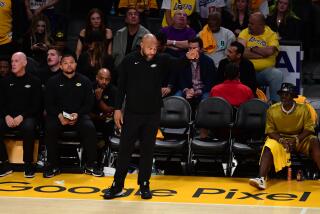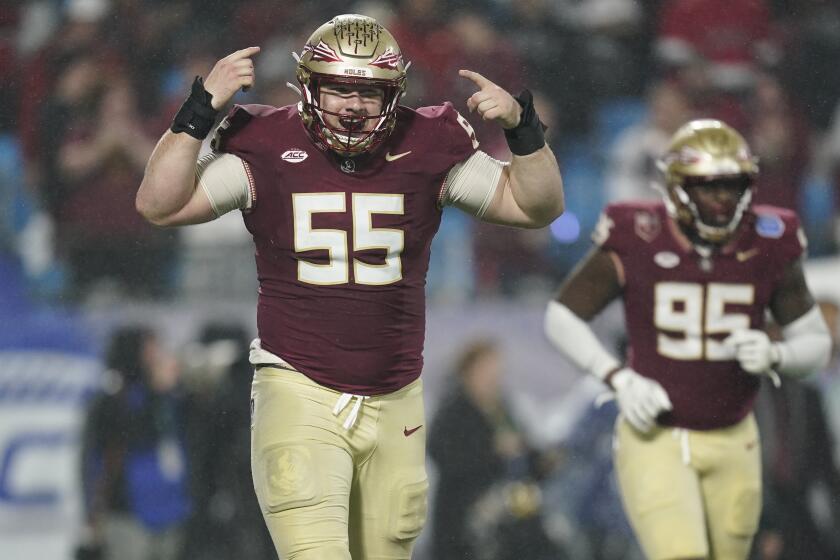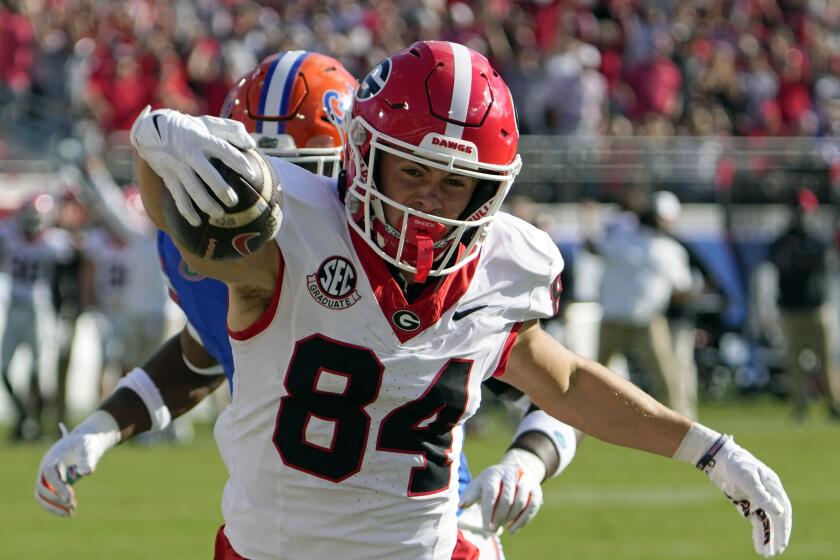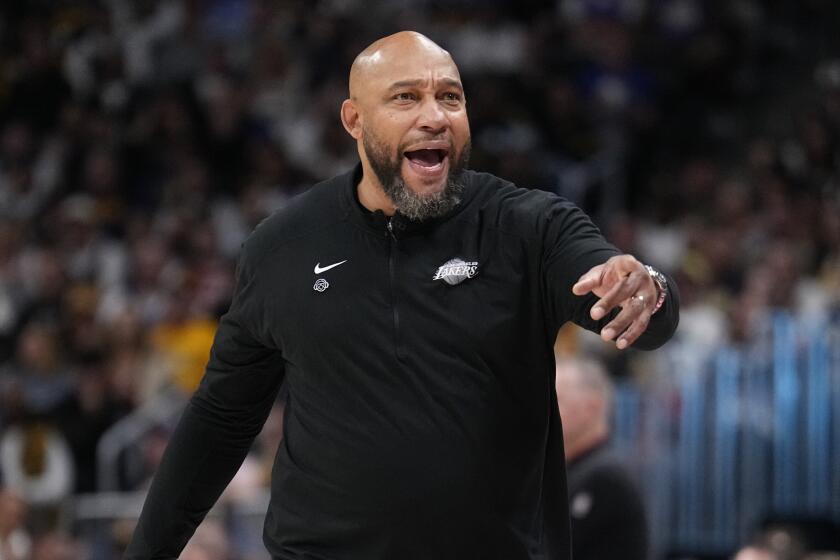Turnovers Overrated
For the first time in a month or so, the Tampa Bay Buccaneers looked like a football team Monday night though scoring just often enough to put down the New York Giants, 19-13.
In the fourth quarter, they never missed a beat after the Giants hit them with a major turnover, an intercepted pass that young New York cornerback Frank Walker ran in for a 56-yard touchdown.
Turnovers are less important than media announcers keep saying.
You don’t root for your side to fumble, but you don’t give it much worry time.
The Buccaneers (5-6) simply shrugged off the New York rookie’s startling interception, and, led by quarterback Brad Johnson, had their way again thereafter with the determined but undisciplined Giants (4-7), who were caught for three critical face-mask fouls and a half dozen other mostly stupid infractions. The Giant coach, Jim Fassel, a good one, has always prided himself on fielding well-disciplined teams, but in this game he appeared to be losing control.
Although more than seven minutes remained after the Walker turnover, there was no shift in momentum as the two quarterbacks, Johnson and New York’s Kerry Collins, went on making good throws and bad against defensive teams that staggered sometimes but never collapsed.
Turnovers Don’t Decide NFL Games
AS A PRINCIPAL CAUSE of victory and defeat, NFL turnovers are widely and wildly overrated. If the San Francisco 49ers best Baltimore next Sunday in turnover ratio as well as in total points scored, you’ll never hear me say that one led to the other.
Look what turnovers did for San Francisco this week when Brett Favre was intercepted at the Green Bay 20 twice in the first half: The 49ers got nothing either time, and eventually lost the day, 20-10.
Turnovers don’t win or lose football games. Coaches and players do. The relevant facts after any interception or fumble are what prompted it and what the two teams do next. In the Green Bay instance, Favre’s broken thumb led to the interceptions — meaning he should be cleared of personal blame — and lax coaching led to the 49ers’ failure to score.
In scoring position, when offensive linemen are flagged repeatedly for illegal procedure, that’s lack of discipline, and that’s a coaches’ problem. And when an offensive team keeps running the ball unsuccessfully into stacked running-play defenses, that’s another coaches’ error. Turnovers are merely something they blather about to insinuate that it’s never the coach who errs.
Five Ram Turnovers Don’t Faze Bulger
THE ST. LOUIS RAMS, taking sole possession of first in the NFC West, turned the ball over five times Sunday — on quarterback Marc Bulger’s four interceptions and a fumble — and won anyway, 30-27, at Arizona.
That was reminiscent of the six turnovers that Joe Montana survived (after his three interceptions and three fumbles) to beat Dallas in the 1980s game that began San Francisco’s long run to an unprecedented five Super Bowl championships.
The Rams in recent weeks have been unable to decide whether they want to be a passing team or a balanced mainstream football team, but at Arizona, where Bulger threw for 329 yards, they were more of a passing team. That day, as all good passers must, Bulger simply ignored the reality that to a passing team, interceptions are part of football.
Doggedly, beautifully, he kept throwing the ball downfield to Isaac Bruce, one of the smoothest and slickest of NFL receivers all-time, and to Torry Holt, another great one. On the Rams’ two winning drives, Bulger executed Coach Mike Martz’s game plan precisely with a series of astounding downfield passes.
Other coaches today magnify turnovers and use those plays as an excuse for losing. By turnovers, they mean, “I did everything right, but my players screwed up.”
At every opportunity, most NFL coaches talk about the severity and power of turnovers, particularly when talking to TV announcers. And they’ve made believers of most announcers who, parroting the coaches’ line, identify turnovers as decisive nearly every Sunday. Not so.
Here’s How to Analyze an NFL Turnover
THE NEW ENGLAND PATRIOTS, en route to Indianapolis for the NFL Game of Week 13 next Sunday, won at Houston this week, 23-20, after Texan quarterback Tony Banks threw an interception in overtime. Deducing that Banks’ turnover was a decisive misstep is, however, simplistic and plainly wrong.
To accurately analyze any interception, sports fans have got to know the correct answers to these particular kinds of questions: Did the intended receiver make a wrong move or was he otherwise impeded, legally or illegally, by opponents? Was the receiver insufficiently instructed? Did the coach who called that play anticipate the defense his players got? Did the offensive line coach have all his players ready and making the right blocks for the play called? Did blocking backs or others miss any assignments? Was the passer taking a calculated chance, as passers sometimes must (in the fourth quarter when losing, for instance, or after a penalty near their own goal line)?
In the Houston instance, a penalty had indeed shoved the Texans backward on the overtime play before Banks, after twice throwing touchdowns, threw the interception. In overtime, against a team with a feared field-goal kicker, Banks had to try to work the ball out a ways if he could. That’s not to say that that’s what happened. But in the NFL, it does happen.
Thus to merely count turnovers — and point a finger at those seemingly responsible — is always premature, nearly always irresponsible, and usually incorrect. And when TV announcers are doing the counting and pointing publicly, it’s always acutely simplistic as well as unnecessarily damaging and, for all they really know about any turnover, probably incorrect. What’s more, it’s a disservice to listeners and players alike. These are mostly all great passers they’re talking about.
Colts Don’t Coordinate Manning, James
THE INDIANAPOLIS COLTS (9-2) have the weapons to turn back New England (9-2) Sunday in a collision of AFC division leaders. Theoretically, they can threaten the Patriot defense on every down with quarterback Peyton Manning and running back Edgerrin James. The Colts’ problem is that their coaches don’t play football that way.
Instead of integrating Manning and James in a coordinated assault, Indianapolis attacks for a while with one of them, usually James, and then the other. So against an inferior opponent at Buffalo this week, the Colts fussed around for three quarters as Manning, before almost every play, walked back and forth visiting awkwardly with his teammates, presumably making or faking audible calls.
Then he handed off to James for a simple line buck.
Or, on third and long, he stood back in shotgun formation to throw a pass that Buffalo expected.
As a consequence, the overmatched Bills were still ahead in the fourth quarter when, with a couple of minutes to play, the Colts finally settled down, quit trying to disrupt the Bills, and pulled it out, 17-14.
Of the many things wrong with Indianapolis’ offensive strategy at this point in time in NFL football, one of the most serious is Manning’s absurd retreat into a shotgun position on most third-down plays. Any defense that can count on a pass — as it usually does when an offense is in shotgun formation — has an excellent chance to beat Manning or any other shotgun passer. It doesn’t have to worry about James or any other ballcarrier on those plays because it’s hard for backs to run from shotgun formation, from, say, a starting point six or seven yards behind the line.
Nor do defenses fear Manning’s passes on first down because James so often carries the ball on the Colts’ early-count plays. Their present record, after winning nine times from teams as good as Tennessee, New Orleans and Tampa Bay, tells you how good their offensive players are, not their offensive coaches.
Manning Has James; Who Does Brady Have?
COLTS’ POSTSCRIPT: The reason Manning figures over New England quarterback Tom Brady Sunday is that Manning has James to lean on whereas Brady has nobody. The Patriots’ ostensible mighty back, Antowain Smith, who was brought in to give them a running game, gained 10 yards on eight carries against Houston.
And although Patriot running back Kevin Faulk added 80 yards, it took him 23 carries. Few teams really fear Faulk, who isn’t quite fast enough for a back weighing only 202 pounds. Thus the New England offense is in the hands of one good man, Brady, who as a big-play passer isn’t much better than the Colts’ superb quarterback.
Indianapolis vs. New England is, however, a meeting of great defensive coaches, Tony Dungy of Indianapolis and Bill Belichick of New England, as well as great passers, Manning and Brady, and, in a game like this, there’s no way to predict which of the four will get hot. There’s no good way, in fact, to figure any pro game in this season of gathering parity — as the Denver Broncos underlined this week during an astonishing loss to Chicago.
Bears Losing with Winning Players
THE CHICAGO BEARS toppled the Broncos Sunday, 19-10, which is a result that makes absolutely no sense except on one level: The Bears have a lot of great players, not as many as Denver has, maybe, but more than many of the opponents in their conference as well as all the teams in their division, the NFC North, except Green Bay.
And who’s to say that, man for man, Green Bay is really superior. Critics would take Brett Favre, sure, over either Chicago quarterback, Chris Chandler or Kordell Stewart. And most would go for Green Bay running back Ahman Green over Chicago’s Anthony Thomas, but that comparison is closer.
If directed by the people on a good coaching staff, Thomas would be putting up numbers not so far behind Green’s. And Chandler would look more like Manning. For, in Chicago, coaching is the problem. Those who coach the Bears are incredibly unimaginative and regressive, or, as they’re normally called, conservative. But they do have some wonderful players on both sides of the ball.
And when good players feel they’re being maligned — as the Bears did when told they were 10½ points the lesser team in Denver — they’re capable of rising up, sometimes, and proving somebody wrong. As a team, of course, by comparison with the NFL’s 30 best teams, the Bears aren’t much, as they showed when stumbling at Detroit, 12-10, and when losing a 49-7 game to a San Francisco team whose players aren’t much if any better than theirs. But at Denver, beyond much doubt, Chicago’s players played some winning football.
So that’s one thing. Another provocative thing is that Chandler was injured. The Denver coaching staff had prepared for Chandler, who can’t run, and in the second half got Stewart, who can. That doesn’t seem important either, but in a 60-minute game it sometimes is.
Sherman, Packers Hoodwink 49ers
THE GREEN BAY PACKERS’ offensive coaches, as supervised by Coach/General Manager Mike Sherman, can be credited with the best work in the NFL during the present interlude when Brett Favre keeps banging his broken thumb — an injury that has basically reduced Green Bay to one-dimension football.
Chancing only 15 passes this week, the Packers called 48 running plays and produced 379 total yards against the 49ers, a result that would have pleased most people in Green Bay had Favre been providing a second dimension.
Moreover, the Packers alternated three running backs, Ahman Green, Najeh Davenport and Tony Fisher, suggesting that, as good as Green is, he has been the beneficiary of some remarkable blocking this year. It takes good coaches to develop good blocking — which is why Denver has had so many effective running backs in the Mike Shanahan era — but, obviously, Green Bay is succeeding beyond the dreams of most blocking teachers.
The enthusiasm with which the Packers block means, of course, that they’d rather perform for running backs than for any passer, even Favre, but more than that it means that Sherman and his assistants are installing the line-play discipline and morale you’ve got to have when you really don’t have Favre.
One more thing: At game time, Sherman and his play-calling aides have cannily misrepresented Favre’s injury to bemused NFL defenses. They have planned and waited for opportunities to pretend that Favre can still pass.
Thus in the 49er game, determining to show off Favre early on, before the 49ers could really be sure he was hurt, and before Favre could get hurt again, they called a bomb on the third play of the game. So his thumb, well-rested at that point, still wasn’t too painful when Favre unloaded a perfect long pass to wide receiver Javon Walker, a second-year receiver from Florida State, for a 66-yard touchdown. That kept the 49er defense unduly anxious about more big passes the rest of the afternoon.
Sherman’s we’ve-got-to-show-them-Favre-occasionally strategy hurt Green Bay several times in the 49er game. He can’t really pass these days so his three interceptions looked pretty awful. But they hurt San Francisco worse than they hurt Green Bay. While the three Packer running backs kept blowing through the San Francisco defense, the 49ers couldn’t keep from worrying about Favre. Deception is the better part of football, as Knute Rockne first said. The 49ers went home and down in the standings, deceived.
Bob Oates’ book, Sixty Years of Winners, is available at latimes.com/bookstore or by calling (800) 246-4042 ($16.95).
More to Read
Get our high school sports newsletter
Prep Rally is devoted to the SoCal high school sports experience, bringing you scores, stories and a behind-the-scenes look at what makes prep sports so popular.
You may occasionally receive promotional content from the Los Angeles Times.






